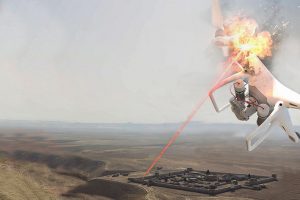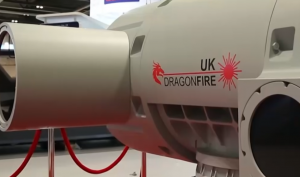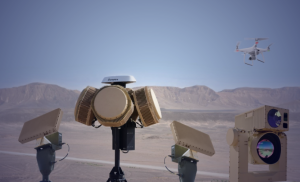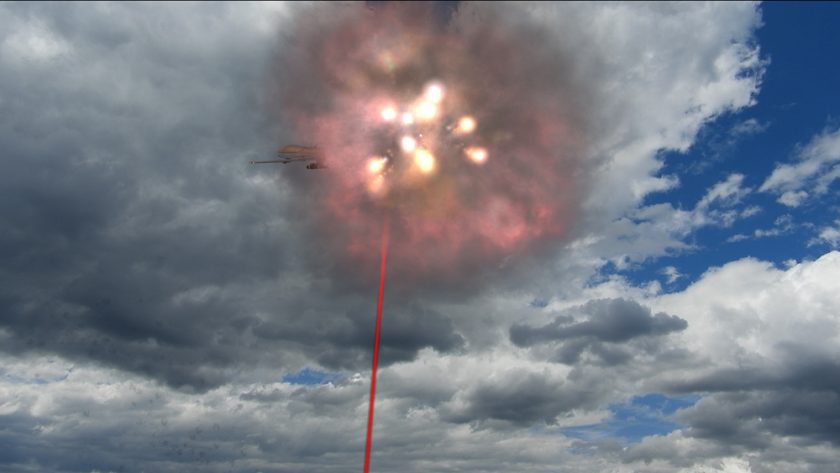By Oliver Smith
It is taking far longer – and costing much more – than originally planned for the world’s militaries to bring lasers for drone defence onto the battlefield.
While the USA and Israel are understood to have deployed high energy lasers (HEL) in some various degrees of operational deployment, there is little evidence, despite claims to the contrary, that a HEL system has successfully engaging an enemy UAS in combat.
Laser weapon systems are currently under development in 18 countries, including 9 of the 10 largest military spenders.
The speed-of-light interface of lasers allows for accurate engagement without the need for calculations of trajectory and also allows for fast re-engagement, an invaluable feature for tackling the threat of drone swarms. Another advantage is the relative cost, the recent democratisation of drone technology, has meant that C-UAS missions using conventional means results in an unsustainable cost imbalance. This issue is easily avoided when the cost of a shot is the price of the electricity required to operate the weapon. This use of electricity also means that as long as the weapon system has access to a power supply it will remain ready to fire, instead of having to rely on a limited number of rounds stored in a magazine. Additionally, engagement using a laser over a missile means that the potential for collateral damage induced by the countermeasure is reduced.
The United States
By far the country with the biggest budget for R&D through to deployment is the United States. To date, the Department of Defense (DoD) has invested billions of dollars in companies such as Raytheon, Lockheed Martin, and Northrop Grumman. These companies have spent more than a decade testing laser systems on Navy ships, fighter aircraft, attack helicopters and Army Stryker vehicles.
The US Army – designated the lead service by the DoD – recently established the Joint Counter-Small Unmanned Aircraft Systems Office (JCO) and is currently defining the US strategy in this field for HEL development and deployment. Maj Gen. Sean Gainey, director of the JCO has stated that high energy lasers will be integrated into the existing counter sUAS architecture as part of a layered, system of systems approach. A number of laser systems are being trialled and developed, and will be deployed to support other capabilities.
One of the longest running laser systems in development for C-UAS missions is the High Energy Laser Weapon System (HELWS) from Raytheon. “With thousands of operation hours under its belt, our HELWS system has proven its mettle” according to Annabel Flores, vice president of Electronic Warfare Systems at Raytheon Intelligence & Space. Having received USD37 million in funding for initial prototypes of small vehicle mounted, air defence weapon system since 2019, the laser will be upgraded with a USD15.5 million contract from the Air Force Lifecycle Management Centre throughout 2021. This upgrade will be to focus on defending air bases against the threat posed by UAS, as well as supporting associated Air Force field assessments and operator training.
According to an Air Force press release in February this year, the HELWS system is undergoing operator training and initial performance evaluation at an unidentified combat command base abroad.

Throughout 2020, the 704th Test Group’s Operating Location AA, part of the Directed Energy Combined Test Force, or DE CTF, focused much of its effort on the testing of weapons designed to prevent adversarial drone observation and assault, according to a Raytheon press statement. The latest system tested, the High Energy Laser Weapon System 2 is a counter-Unmanned Aerial System (c-UAS) directed energy weapon (DEW).
Another land-based system undergoing testing abroad is the Tactical High Power Operational Responder (THOR) system – a high-energy microwave laser directed-energy weapon developed by the Air Force Research Laboratory (AFRL). This is a counter-swarm weapon, requiring minimal set-up for fast deployment and is designed to protect airbases.
Boeing recently announced a USD2.5 million upgrade to its Compact Laser Weapon System (CLWS) which has been on active service with the Marine Corps. The system can be installed on a variety of land vehicles and is being promoted to the US Navy. Boeing also developed the vehicle-mounted Avenger system with a 10 kW laser
For the Navy, the Lockheed Martin High Energy Laser with Integrated Optical-dazzler and Surveillance (HELIOS) system has undergone system integration testing with the AEGIS combat system and factory testing, demonstrating full power operation above 60 kW. HELIOS is due to be integrated with AEGIS into an Arleigh Burke destroyer this year.
Northrop Grumman entered into the field of DEW systems in 2019, pitching against Raytheon for the Army contract to supply a 50 kW Stryker mounted laser. However, due to overheating issues with the power and thermal management system, they pulled out of the competition
A new development being sponsored by the Navy and Marine Corps Science & Technology department is in the field of airborne C-UAS. It was announced in August this year that MZA Associates – a specialist in research and analysis of DEW systems – has been awarded a contract worth USD18.7 million to develop a HEL Weapon System that is compact, portable, and low-cost.
Further systems in development include the Applied Technology Associates (ATA) Directed Energy Weapon, which recently received a USD17.6 million award for Phase 1 development of a fixed-site Counter-UAS prototype, building on its LOCUST programme. In October 2020 General Atomics and Boeing announced a partnership aimed at delivering a High Energy Laser Tactical Vehicle Demonstrator (HEL TVD) laser system, scalable from 100 kW to 250 kW. A Dynetics and Lockheed Martin team were awarded a US Army contract in 2019, worth USD130 to develop a HEL TVD system which includes a 100 kW laser aimed at defending against rockets, artillery, mortars, cruise missiles as well as drones.
Europe
The European Defence Agency (EDA) has been working on a three year project to advance European capabilities in laser technologies. The Tactical Advanced Laser Optical System (TALOS), launched in 2018, is a consortium of 16 companies, laboratories, and universities from 9 European countries led by the French laser and optronics specialist CILAS – part of the Ariane group. The project will develop and demonstrate critical Laser Directed Energy Weapon (LDEW) technologies, aimed at countering Rocket Artillery and Mortar (C-RAM) as well as UAV threats. This will inform the design and build of a compact high-power laser (100 kW) to be integrated in military applications by 2025. The system will also be operational on maritime, land and air platforms.

In the UK, a joint laser system project is underway operated by a group of companies known as the UK Dragonfire consortium. Led by missile defence specialists MBDA, and comprising Leonardo, QinetiQ, Arke, BAE Systems, Marshall Land Systems and GKN. The system, built for C-UAS and C-RAM is expected to begin trials in 2023 on Royal Navy ships and British army vehicles, and the potential for integration into aircraft such as sixth generation fighters is already under review.
A contract from Germany’s Federal Office for Bundeswehr Equipment, Information Technology, and In-Service Support (BAAINBw), has been awarded to MBDA Deutschland GmbH and Rheinmetall Waffe Munition GmbH who will collaborate to create a HEL weapon for deployment at sea. The demonstrator is to be created by the end of 2021 and trials under highly realistic conditions aboard German frigate F124 Sachsen are scheduled for 2022.
As well as leading the development of the EU TALOS project, French defence company CILAS is to begin testing its small two-kilowatt laser with the French Navy. The company has been testing its HELMA-P laser platform – which has an effective range of about half a nautical mile – on target drones in France since 2020.
A further collaboration involving CILAS and MBDA has also recently been announced. The European companies have signed a memorandum of understanding with UAE defence firm SIGN4L – an electronic warfare and intelligence specialist – to explore co-development opportunities particularly in the field of HEL weapons systems for C-UAS.
Estonian defence company Marduk Technologies is developing an electro-optical C-UAS platform, the Marduk Shark, which has the potential for mounting a laser system. They recently teamed with Milrem Robotics to give the system portability. The Shark is mounted on Milrem’s THeMIS – an unmanned ground vehicle, to give combat forces increased protection and mobility.
Principally the US and European systems have been designed to protect military infrastructure and other potential targets – warplanes, ships, land vehicles etc. when deployed in war zones, foreign territories, or international waters. So, what is the state of laser C-UAS development in other countries, particularly in the Middle East and Asia, where the threat is mainly from cross-border incursions, surveillance, and localised attacks.
China
Recent information about Chinese DEW systems is scarce. Chinese media announced in 2014 that it had successfully tested its Low Altitude Guard I 10 kW laser against a range of small UAVs. The system has a reported range of up to 2 km. Low Altitude Guard II debuted at the 2016 Africa Aerospace and Defense tradeshow and appears to be an upgrade to the previous Low Altitude Guard, utilising a 30 kW laser with a range of 4 km and compact enough to be vehicle-mounted. A significant separate development, around the same time, was the Silent Hunter system, which requires two large vehicles to be operational. The laser has a power level of 30-100 kW.
In 2018, the China Aerospace Science and Industry Corporation (CASIC) showcased its latest C-UAS weapon, the LW-30. This was built onto a 6×6 modified Wanshan WS2250 and, according to CASIC, the complete system includes a command and communications centre and other support vehicles. The 30 kW laser is designed to take down manned and unmanned aircraft and works as a C-RAM weapon. It claims to have an effective firing range of up to 25 km, although this hasn’t been substantiated.
Another system, developed by Guorong Technology and the China Electronics Technology Group, the Guorong-1 is a short-range, vehicle-mounted ground-to-air laser weapon system that can down a UAV from hundreds of metres away.
Light Shield, unveiled at the Zhuhai Air Show in 2014 is another vehicle-based C-UAS system that combines early warning, identification and interference devices and has a laser generator to damage or destroy the target. Developed by China Electronics Technology Group.
Reported in 2020, the Chinese military put out a request for a laser attack pod, and although the tender details are confidential, it is speculated that this is for an aircraft-based tactical weapon. Also reported in the South China Morning Post in 2020, China is installing 20 megawatt generators to its warships to power high-energy weapons and rail guns.
There are also claims that a Chinese handheld laser weapon system, the ZKZM-500, is in development, capable of destroying material and being lethal to personnel. However, this is something strongly disputed by many industry experts.
Russia
In Russia the Peresvet system (a play on the name of a Russian warrior monk that also translates as literally as “over-light”) is currently deployed in active service with five of the Russian Federations Strategic Missile Forces for the purpose of air defence. The system has the ability to damage the optical system of aircraft, drones, cruise missiles and satellites – although, it is not powerful enough to physically destroy targets.
Accurate information surrounding this system is highly guarded by the Russian Federation’s Ministry of Defence. Stories of Peresvet’s successful engagement of Israeli drones over Syria have appeared in various Russian and online media, however, there has been no confirmation of this from the Russian MoD or the IDF.
Israel
Over the last 20 years, Israel has found itself sorely in need of a low cost per shot air defence system. Challenged with low-cost high-quantity rocket attacks, HEL systems provide a far more economically viable solution to this over other deployed Israeli air defence measures such as the missile-based Iron Dome.

RAFAEL describes its Drone Dome system as “combat proven”
Currently the Israeli arms research and manufacturing company Rafael is working on HEL technology for weapon systems such as the Iron Beam and Light Blade which saw deployment to the Gaza Strip in August of last year. This deployment saw the system largely used against improvised rockets and incendiary balloons as well as UAS.
In June, Israeli defence company Elbit, working in conjunction with the Israeli Ministry of defence and Air Force completed tests of an airborne C-UAS laser system. To carry out C-UAS missions using lasers form an airborne platform is a highly unique and sought after capability. Israel has a high number of C-UAS systems deployed and in development.
Turkey
Discussing the need to develop direct-energy weapons, Ozgur Eksi, an Ankara-based defence analyst, stated that “Drone warfare architecture may be the most critical operational use, especially for asymmetrical warfare inside Turkey or in cross-border operations [in Syria and Iraq].” Consequently, Turkey has invested tens of millions of dollars into laser C-UAS and C-RAM technology and has two systems under development.
The first, Alka, is built by the state-controlled missile-maker Roketsan. It uses a 50 kW laser and electromagnetic systems to disable a swarm at up to 4,000 metres and destroy a specific target at 500 metres. Roketsan are currently working on integrating the system into a dedicated land vehicle. The Alka system has been described as having shot down an enemy UAS in combat in Libya, this would be a first of its kind engagement, however this claim is widely disputed. The second system is the LSS laser defence system developed by military electronics specialist Aselsan. The LSS targets mini and micro drones up to 500 metres away and it has the ability to track multiple targets. It is designed to be either vehicle or ship mounted.
(Main image: Shutterstock/Antrakt2)




